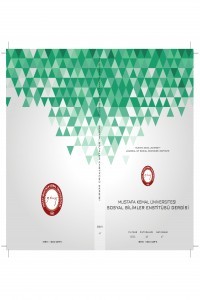Web 2.0 Technologies Forge The Way For Global Citizenship/Web 2.0 Teknolojisinin Global Vatandaşliğa Etkisi
Abstract We elucidate for instructional designers the competencies of global-citizenship and provide an activity framework that designers can use when designing instruction that prepares learners for global citizenship. The framework consists of issues of poverty, earth stewardship, spirituality, diversity, language, privacy and open access, and government. We describe Web 2.0 affordances that support activism in global-citizenship and provide an array of websites that harness Web 2.0 capabilities for participation. Activities that take advantage of Web 2.0 affordances can be integrated into instruction across the curriculum to harnesses the collective intelligence of individuals so that they can act as global citizens. Key Words: Web 2.0, global citizenship, instructional design Web 2.0 Teknolojisinin Global Vatandaşliğa Etkisi Özet Makale, öğretim tasarımcıları için küresel vatandaşlık yetkinliğini aydınlatmayı ve öğretim tasarımcılarının öğrencileri küresel vatandaşlığa hazırlamaları için talimat tasarlarken kullanabilecekleri bir etkinlik çerçevesi sağlamayı amaçlıyor. Etkinlik çerçevesi yoksulluk, toprak yönetimi, maneviyat, çeşitlilik, dil, gizlilik ve açık erişim ve hükümet konularından oluşuyor. Makale, Web 2.0'in küresel vatandaşlık etkinliğine sağladığı desteği açıklayıp, web site dizinlerinin oluşturduğu Web2.0 imkanlarının katılımcılar için sağladığı imkanları ifade ediyor. Web 2.0 destekli etkinliklerin öğretim programına entegre edildiğinde bireylere sağladığı kolektif zeka, kişilerin küresel vatandaş olarak hareket etmesine olanak sağlar. Anahtar Kelimeler: Web 2.0, global vatandaşlık, öğretim tasarımı
Anahtar Kelimeler:
Web 2.0, global vatandaşlık, öğretim tasarımı
___
- References
- Barna, L. (1998). “Stumbling block in intercultural communication”. In Bennet, M. J. (Ed.), Basic concepts of intercultural communication. Boston, MA: Intercultural Press.
- Bonk, C. J. (2009). The world is open: How web technology is revolutionizing education. San Francisco, CA: Jossey-Bass.
- Cifuentes, L., Merchant, Z. & Vural, Ö., F. (2010). “Harnessing Web 2.0 for global citizenship”. Learning and Leading with Technology, 38(3), 34-35.
- Cifuentes, L., & Murphy, K. L. (2001). “Promoting world citizenship: Cultural connections via telecommunications”. In R. Nata (Ed.), Progress in education (pp. 101-131). Huntington, NY: Nova Science.
- Dewey, J. (1916). Democracy and education. New York: Macmillan.
- DiNucci, D. (1999). Fragmented future. Print, 53(4), 32.
- Hofstede, G. (1997). Cultures and organizations, software of the mind: Intercultural cooperation and its importance for survival. New York: McGraw-Hill.
- Ikeda, D. (1996). “Columbia daigaku deno SGI kaicho no koen. Seikyo Shimbun”, 16, 6. Retrieved July 13, 2009, from http://www.daisakuikeda.org/main/ educator/edu/edu-10.html#sdendnote1anc
- O'Reilly, T. (2005). "Web 2.0: Compact Definition?" Retrieved July 13, 2009, from http://radar.oreilly.com/archives/2005/10/web_20_compact_definition.html
- Parker, W. C., Ninomiya, A., & Cogan, J. (1999). “Educating world citizens: Toward multinational curriculum development”. American Educational Research Journal, 36(2), 117-145.
- Posner, G. (2004). Analyzing the curriculum. New York: Mc Graw-Hill.
- Postman, N. (1993). Technopoly: The surrender of culture to technology. New York: Vintage.
- Postman, N. (1995). The end of education. New York: Vintage.
- Schubert, W. H. (1986). Curriculum: Perspective, paradigm, and possibility. New York: MacMillan.
- Shah, A. (2009). Poverty facts and stats. Retrieved March 23, 2009, from http://www.globalissues.org/article/26/poverty-facts-and-stats
- Soloman, G. & Schrum, L. (2007). Web 2.0 new tools, new schools. Eugene, OR: International Society for Technology in Education.
- Storti, C. (2001). The art of crossing cultures. Yarmouth, Maine: Intercultural Press.
- Timm, J. T. (1996). Four perspectives in multicultural education. Belmont, CA: Wadsworth.
- Başlangıç: 2004
- Yayıncı: Hatay Mustafa Kemal Üniversitesi
Sayıdaki Diğer Makaleler
Mehmet İLBAN, Mehmet AKKILIÇ, Özer YILMAZ
Bayram AKARSU, Hilal COŞKUN, İ. Afşin KARİPER
SINIF ÖĞRETMENİ ADAYLARININ BİLİMİN DOĞASI KAVRAMLARI: TEORİ, YASA VE HİPOTEZ
Erdal TATAR, Yunus KARAKUYU, Cengiz TÜYSÜZ
Murat ÖZBAY, Kadir BÜYÜKİKİZ, Yusuf UYAR
Esin ŞAHİN, Sedat MADEN, Mehmet KARDAŞ, Abdullah ŞAHİN
